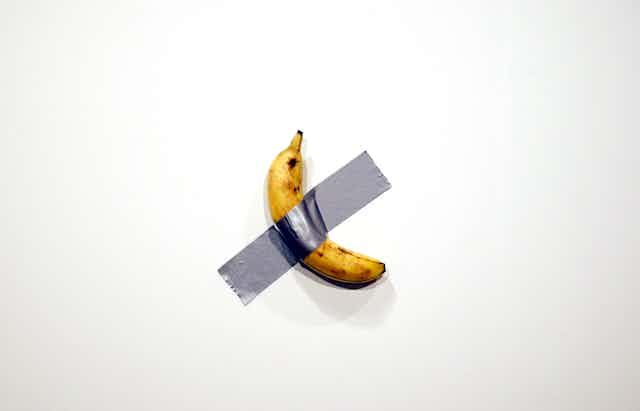In September, the Guggenheim Museum in New York acquired Maurizio Cattelan’s Comedian by anonymous donation. The work – a banana duct-taped to a wall — was first shown and sold at the Art Basel fair in Miami Beach in the autumn of 2019 where it generated attention, derision and innumerable memes. Social media was, for a brief time, overflowing with images of just about anything duct-taped to walls: tamales, beer cans, cabbage, a durian fruit, a sandal, someone’s cat. Companies quickly countered with online ads where their products, from deodorants to French fries, were shown duct-taped to the wall with a modest price tag.
Comedian reignited a set of questions that seem to flare up with some regularity: what makes something a high-priced artwork when another, seemingly identical, object is not?
Since the work was shown at an art fair, it is relevant to consider what exactly is being bought when acquiring an artwork like Comedian. The original banana had to be replaced several times during the course of the fair, once after it was eaten as a stunt by another artist.

The collectors who bought and subsequently donated the work to the Guggenheim did not receive an actual banana or a piece of duct tape. Instead, what they got was a document, a so-called certificate of authenticity that granted them the right to recreate the work and instructions of how to do so. It stipulated, among other things, that the banana should be hung 175cm above ground and that it should be replaced every seven to ten days.
A banana is a banana is a banana
Although the art world has accepted the idea of ready-made everyday objects as art, at least since the mid-20th century, Cattelan’s artwork invited a collective focus on the structure of evaluation of artworks. If anyone can tape anything to the wall — as many did — what is the point of a document granting the legal right to do the same?
Let’s compare Comedian to another fruit-based artwork: Zoe Leonard’s Strange Fruit (1992-1997), a large installation of fruit peels, carefully stitched together by the artist. It was made during the Aids crisis and functioned as a ritualised act of mourning and memorialising.

After closely working with a conservator who developed a method of halting material decay at a particular point, Leonard decided that it was more in line with the work’s idea to have it turn slowly into dust. In contrast to Comedian, replacing the fruit peels was not an option since the specific acts of stitching as mourning was key to the work’s meaning. The material manifestation of Leonard’s organic objects is far from stable – time passes and they change – but it is crucial that it is these precise pieces of fruit that undergo that transformation.
Conceptual artists in the 1960s argued that an artwork’s identity is not to be found in its physical manifestation but in the artist’s idea. That idea can, but does not have to, take material form.
Following that logic, the material object is a manifestation of an idea, and it is the idea that is bought and sold on the art market. When the object is reproducible or immaterial, the certificate of authenticity ensures the artwork’s identity as an artwork. Comedian is not dependent on a specific banana, any banana could be used without altering the meaning of the work. That, however, is very different from saying that any banana and piece of duct tape is an artwork by Maurizio Cattelan.
Poking fun at the market
Even though the US$120,000 (£92,000) price tag for Comedian was by contemporary art standards fairly moderate, it is obviously a huge mark-up for the act of combining two very cheap and readily available materials.
The work’s title hints that it is aware of the comedic absurdity of its own evaluation on the art market. Also, the banana’s upward curve on the wall recalls a stylised smiling face, and the banana peel, as we know, is involved in the most basic of slapstick skits.
Comedian was in fact not the first time Cattelan poked fun at the market, art dealers and their place within this system. In 1995, he made his dealer Emmanuel Perrotin (in whose booth at Art Basel Comedian was shown) dress up as a giant pink penis-shaped bunny for the duration of his exhibition at Perrotin’s Paris gallery. The piece was called “Errotin le vrai lapin (Errotin the true rabbit). By making Perrotin wear a ridiculous and humiliating phallic costume while carrying out his day-to-day work as a commercial gallery owner, the spectacle of the art market came into sharp view.

Comedian is not the only of Cattelan’s works that has drawn attention to the Guggenheim in recent years. In 2016, the artist installed the work America in one of the lavatories of the museum. The 18-karat gold toilet is a tongue-in-cheek commentary on the excesses of America’s rich; a piece of satirical participatory art that welcomes people to actually use it. It has reverberations of Marcel Duchamp and Sherrie Levine’s lavatorial works.
It could have been President Trump’s after he requested to borrow a Van Gogh from the Guggenheim but was offered America instead – he declined. It then was taken in by Blenheim Palace in Oxford in 2019 where art critic Jonathan Jones commented:
How does it feel to urinate on gold? Much like peeing on porcelain. But here, among all the photos of young Winston, it also feels like pissing on British history.
Soon after, it was stolen. Its whereabouts remain unknown.
Cattelan’s works — like other pieces — must be considered in relation to other artworks and the structures in which it operates. The questions they raise are relevant but in part unanswerable: are we to take Comedian seriously, or is it an elaborate joke? And if it is a joke, who is in on it and who, or what, is mocked?

